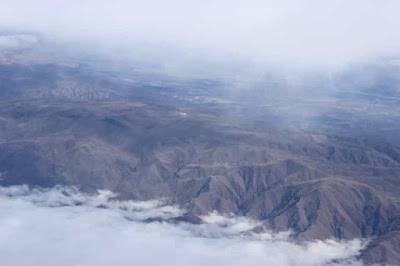We had to decide when we got out of customs, between a bus into the downtown station and a cab. In the end, the cabs were only about $33 into town and would take us directly to our home stay, that was arranged by the language school where we begin a week of Spanish lessons Tuesday. (Monday is Argentina’s National Day, so no classes.). Our driver was friendly and spoke very little English and so I had to use my Spanish and we managed fine.
My pictures on the way from the airport were on my iPhone and I still haven’t figured out how to get them to the iPad.
We’re in an apartment on the 4th floor - very nice, and the host is great. Her English is terrific, which isn’t good for our Spanish, but we are learning a lot about Argentina and Buenos Aires. She has a couple of young men staying here too who are also going to the language school.
We went out last night just to get our bearings - well, we were trying to go before it got dark, but with the clouds it was already pretty dark at 5pm - and to get a bus card - SUBE - and Argentine chips for our phones. We got both, but still haven’t gotten the phone chips fully activated.
This morning I didn’t wake up until 11am. When I got to the bathroom, the light didn’t go on. But there’s a window. I didn’t think much about it. But then our host told us that there was a power outage for all of Argentina and parts of Uruguay and southern Brazil. For us, there wasn’t a big impact. No internet. But the stove is gas, so we could make breakfast. It was raining, hard, then light, then hard again outside. There was some thunder and lightening.
But eventually we decided to go the Museum of Belle Arts - seemed like a good idea for a rainy day. The collection includes many famous European artists. Nothing spectacular that I notice. There was a room of Rodin, and examples of different periods including Rembrandt to Modigliani. There was one red room with a lot of pictures that was someone’s collection donated to the museum. (1)
But then we found an exhibit of Argentine artist Carlos Alonso. Wow! What powerful stuff. He was born in 1929 and studied in Argentina and Europe. His work is full of allusions to other artists’ work and politics. From Wikipedia, we learn, perhaps why:
“Alonso married the artist Ivonne Fauvety.[7] Following the coup of 1976, and the disappearance of his daughter Paloma (born 25 July 1956) the following year, Alonso went into exile in Italy, and in 1979, he moved to Madrid. He returned to Argentina two years later. The Bienal de Pintura Paloma Alonso. named in her honor, is a 1990 joint initiative of Alonso and Teresa Nachman“
Though there were already pieces from the 60s that were pretty edgy. [Due to the troubles I’m having with blogger in my iPad, I’d doing this in Pages and will cut and paste it into blogger and see if that works better. But I’m not going to try to mix pictures and text too much because that’s been problematic on the iPad.]
(2) Sin Pan y Con Trabajo [Without bread and with work](1968)
Alonso: “One of the keys that explain the life of Van Gogh is that he (perhaps every painter) becomes the sine of a society. Van Gogh is the sign of something that is rotting and that a new world is born. What he creates is“ (3)
The Hospital (1974) (4)
The Palm (1952) (5)
Anatomy Lesson 1979. (6)
“Carlos Alonso was inspired by Rembrandt’s The Anatomy Lesson of Dr. Nicotlaes Tulp (1632) as the starting pint for the series dedicated to the death of Ernesto “Che” Gueverra. In these works begun in 1969, the body of the recumbent Che also recalls the famous Christ of Andrea Mantegna, from the 15th century. [There are several paintings, only the one is shown. Not this one.]. The scenes Alonso presented also gave hints of a torture table and the photographs of the dead Guevara that circulated at the time and that were the source of the series.What emerges out of the intermingling of the various images is a hybrid of meaning between that figure of Christ and that of Guevera. At the same time , Alonso sparks a second interchange: that of the languages of the eras of Dr. Tulp and of Che. Figures from the 17th century blend with those of the 20th century, rendered in the manner of pop art and advertising codes.” From the exhibition description English version
We had pizza near the museum walked a bit, then took the bus back. But in what was by then dark with the bus windows fogged up, we went past our stop. Though I’m not sure we would have seen it under better conditions. But we figured it out and got back ok.
[Sorry I can’t adjust the fonts either.].
[Sorry I can’t adjust the fonts either.].





















